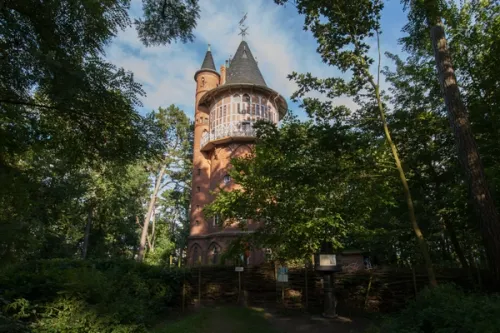Bodensee's surface area
536 km²
State
Baden-Württemberg and Bavaria
Emily McDonnell
From Monkeys to Medieval Castles: A Weekend Guide to Bodensee

Bodensee, or confusingly named Lake Constance in English, sits at the meeting point of Germany, Austria, and Switzerland, with the Alps as a backdrop. The region, beyond its watersports, is known for its orchards, hop fields, and cycling and hiking routes, making it perfect for a weekend of exploring. We stayed at three different accommodations—kindly organised by Tourism BW—allowing us to wake up in various parts of the region.
We started our trip at Hundweilerhof, a family-run farm boasting sleek back cabins that overlook the ancient apple orchards. From here, we visited some of the surrounding local farms, where harvest celebrations were going on (think Berlin DJs, street food stands, and striking autumn colours), before ending our day in the sauna at Hundweilerhof.
Don't Get Fomo
Fernweh Newsletter
Discover Germany, beyond its tourist spots: get adventure tips and day trip inspiration straight to your inbox. Every month, for free. Sign up so you don’t miss out.



The next morning, after a hearty breakfast of locally, homemade produce, we headed out along the country roads, descending to the edge of Bodensee. These are the places we stopped that we truly loved.
1. Pfahlbauten Unteruhldingen
Pfahlbauten translates to “pile dwellings”, and as we strolled along the promenade in Unteruhldingen, it was pretty impressive to see a cluster of wooden buildings jutting out the water. These are reconstructions, but, if you choose, you can visit the museum and see some of the original UNESCO-listed structures underwater, that have been preserved for thousands of years thanks to the lack of oxygen in the mud. In addition, the museum explains about the discovery and preservation of the existing structures.
2. Affenberg Salem
After a little bit of Stone- and Bronze-Age immersive history, we headed to ‘Monkey Mountain”, a wildlife park where over 200 Barbary macaques live and roam freely in an enclosed forest. Feeding them bits of popcorn (provided by the park) was a highlight, especially when they casually walked beside us (these sneaky monkeys know what’s up!). There’s also a stork conservation area, too, and the entire forest is the perfect place for a long stroll.
3. Meersburg
On our way to our next stop, we took a break in Meersburg to explore the super quaint village with its colourful houses and Baroque palace. It's surrounded by vineyards and has spectacular views of Switzerland and Austria, so we simply spent our time here strolling through the streets and drinking coffee; we also stuck our heads in at the Medieval fortress, which is Germany’s oldest inhabited castle.


Next we checked into the gorgeously unique Streuobst Chalets, modern treehouse cabins surrounded by orchards and vineyards. Check out our full review, including the highlight that was our goat walk…! When we were able to pull ourselves away from our sauna and terrace with mountain views, we jumped on our bikes and headed into town (rental bikes can be delivered to the chalets).
4. Zeppelin-Radweg
Cycling through the forests and past hops, which this area is renowned for, this bike route connects key Zeppelin-related sites through the countryside and into the town of Friedrichshafen, where the Zeppelin were produced. The path is well-marked, mostly flat, and passes through orchards and small towns - there are a few places to stop for a cider and slice of cake.
5. Zeppelin Museum
Once in Friedrichshafen, we headed straight to the Zeppelin museum to learn more about these giant airships. The museum, right at Bodensee’s edge, tells the story of Zeppelin airships, and includes a full-scale reconstruction of part of the Hindenburg - the airship that caught fire and crashed in 1937, marking the end of commercial Zeppelin travel and becoming one of history’s most infamous aviation disasters.

For our last night, we checked in at the oh-so-elegant Hotel Krone 1280, with its bar that was giving us serious James Bond villain’s lair vibes! While we were a little north of Bodensee, it’s a great place to stop on the way back to Stuttgart (where we caught a train back to Berlin).
6. Fürstenberg Brauerei Tour
A trip to southern Germany wouldn’t be complete without a brewery visit! Fürstenberg, in Donaueschingen, has been making beer since 1283. We were lucky enough to have a tour, where we got a behind-the-scenes look at the brewing and bottling process. There are also small-scale beer brewing workshops available, which we have our eyes on for next time!
7. Donauquelle – The Start of the Danube
After a lunch in the brewery restaurant, we were picked up by a local expert from the tourism board, who took us on a walk around Donaueschingen, heading to the small spring that marks the official source of the Danube River. We spoke about the history and significance of the spring, and it was a cool feeling to stand at the beginning of one of Europe’s most famous rivers, watching the water bubble up from the ground before its long journey to the Black Sea.

We were a big fan of the parts of Bodensee we visited, and very much enjoyed the balance of historic sites, unspoilt nature, and regional flavours - always with the lake as a backdrop - without feeling we were somewhere overly touristy. Thanks again to Tourism BW, and we’re looking forward to our next trip.


